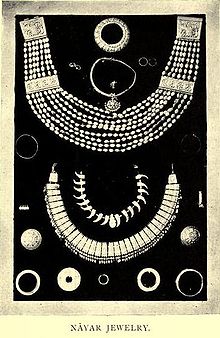- Nair attire
-
The traditional attire of the Nair community was similar to that of the other forward castes in Kerala.
- "The Nairs are rather a fair and comely race, with neat features, clean limbs and decidedly a noble look."-"Goa, and the Blue Mountains", Richard Francis Burton
The dressing style of women was not generally distinguishable from that of men. On festive occasions the Pudava, a gilt bordered mundu, was worn. After the introduction of the Rauka (blouse) in the early 20th century, this particular dressing style went out of fashion. The mundu is still widely used by almost everybody in Kerala, though Western clothing, has found tremendous acceptance as well.
Women
- "Olive colored they (Nair Women) grow their ears long and consider it fashionable, they wear gold and silver ornaments in the big ear holes... They grow hair and tie it in a peculiar fashion on the head. Chewing betel leaf is common and their teeth are thus often black in color."-Logan, Malabar Manual
- "... their women be of great beauty and rare to catch sight of... possessing fine neat features... befitting the noble class"-John Kanding
Women had for the neck ornaments such as the Kantasaram, Nalupanti, Addiyal, Ponnu-Nool, Nagapadam (the most important ornament of a Nair lady), Arimbu Mani, Jnali Kuzhal, Minnum Maniyum, Arasillatali, Pachakkatali, Kasu Malai, Kuzhalmala, Rasi Tali, Padakkatali etc. For the nose, pendants called Mukuttis were worn set with ruby or diamond generally. For the arms, bangles such as Kattikappu, Maniyalakappu, Swarna-Sangala Muduku etc. were worn. For the waist, ornaments known as Kacchapuram were worn. Young girls wore ornaments even on their feet, known as Thanda or Padaswaram. The Nair ladies extended their ear lobes and the only two types of ornaments which were worn in the ears were a type of cylindrical ornament known as Takka or a two lipped biconvex disc considered more fashionable, known as the Toda. Jewels were not worn on the head. Tattooing was not favoured among the Nairs and was considered demeaning.[1]
Similar to men, women also wore a white Mundu, although the upper cloth was usually worn to cover the chest. Like other communities in India, the blouse was traditionally worn, see Mundum Neriyathum.
Men
Men usually, besides amulets and rings, had their ears pierced and wore earrings studded with precious gems. The Nair men wore a Kuduma similar to the Nambudiri style, however this practice began fading since the early 20th century. The white mundu was the traditional garment, usually worn with a white cloth which was placed on the shoulder, or wrapped around the upper body.
References
- ^ Travancore State Manual 1906 by Nagam Aiya, Vol II page 351
Categories:
Wikimedia Foundation. 2010.


